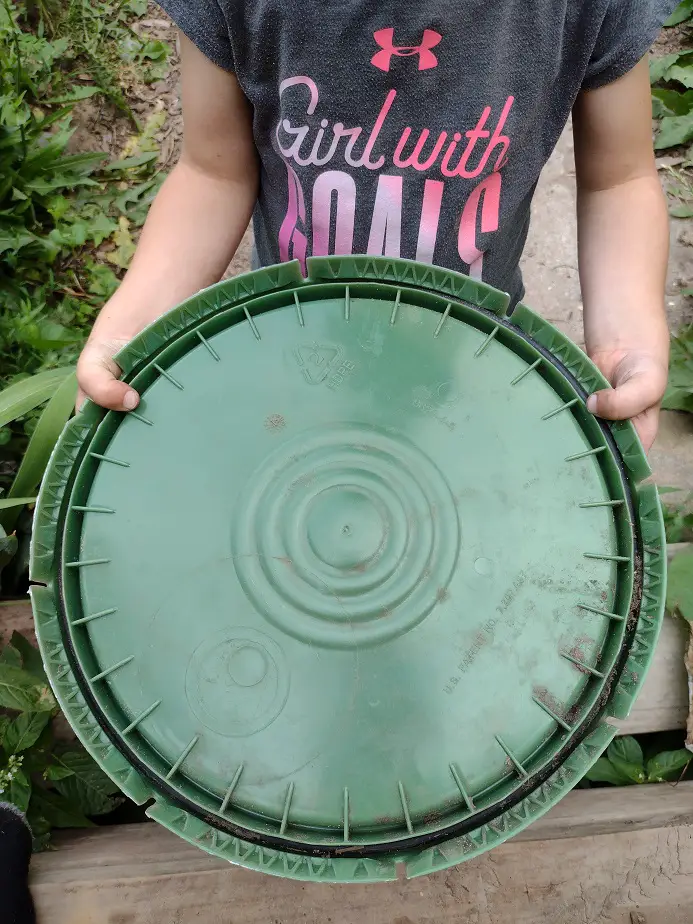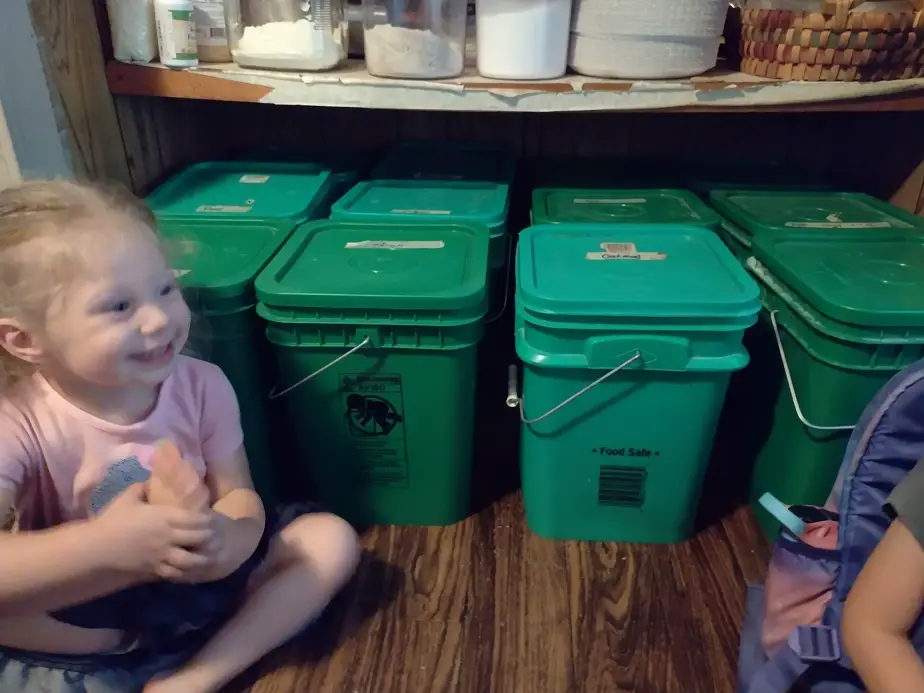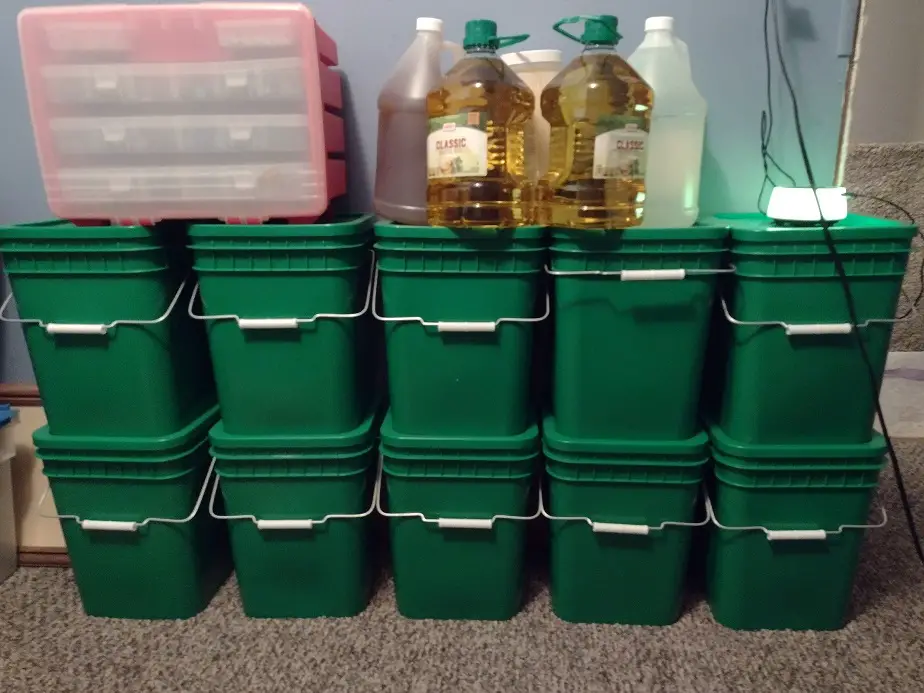Between grains, beans, and dehydrated foods, we have several months worth of food stored in buckets and I’ve become picky about which buckets we use.
The Best buckets for food storage are the Life Latch bucket and Economy 4-gallon square buckets from usplasic.com. The Life Latch bucket is easy to open and maintains a seal better than any other bucket. The Economy 4-gallon square bucket fits well on pantry shelves and is cheap and durable.
There are a lot of different buckets out there and depending on how you’re using them, you have a lot of good options. Let’s go over all the options and considerations.
What Buckets Should I Get for Food Storage?
Plastic, food-grade buckets with a good seal and a minimum thickness of 70 mils are the preferred option for food storage. There are 3 main styles of buckets and the best one for you will be determined by your intended uses. Let’s get into it.
Traditional 5-gallon plastic buckets with a snap-on lid and rubber sealing ring are by far the most common option. They can be bought at a home improvement store, and are relatively inexpensive. They’re also generally fairly stout. The big problem with them, in my opinion, is the lids.

The round lids that snap on, they go on tight. They go on hard and come off hard. You end up putting a lot of pry on the lids as you try and remove them. If you have hand or wrist problems, They may not be a good idea for you. There is a lid removal tool that helps with getting the buckets open.
The lids need a bit of force to go on well. I smack them with my fist to seat the lid and get them to seal. You can use a rubber mallet for that if you have bad wrists or find it tough. So, that’s one set of drawbacks. Here are a few more.
The lids can easily be damaged, cracked, or bent out of shape from repeated removal. You really have to pry to get a well-sealing (of the standard round variety) to come off. Repeatedly taking it off wears out the seal, stretches it out of shape and can cause it to not seal well.
These lids are not designed to keep a seal with repeated use like that. They are more intended to be left in place for a while. If you are planning on just filling a bucket and letting it set, then it may be a fine option for you. Buckets with this type of lid are fine for set it and forget it storage.
The next common type of bucket is a round bucket with a screw-on lid. The most common lid type like this is known as a gamma lid. It’s a 2-piece lid that really takes a step up from the standard snap-on lid. Gamma lids snap on and have a rubber seal like the other one, but it has a screw-on/off center.
The gamma lid has a threaded outer ring that snaps on tightly and the main part easily screws on and off. The whole thing seals very well and is made much more sturdy than standard lids. They are made by several companies and fit most standard 5-gallon round buckets. These are made for regular use.
My favorite type of screw-on lid is called the Life Latch. It’s a proprietary design by usplastics.com and they have lids to fit a ton of different-sized buckets. They seal better and are easiest to take on/off than gamma lids. The Life Latch is a one-piece design that screws right onto the bucket.
They also use a neoprene seal instead of rubber. From my experience, neoprene lasts much longer than rubber so that’s a huge plus. Here’s a link to it if you want to take a quick look. Life Latch Buckets
The only drawback is that they only fit Life Latch buckets, which are only available from usplastics.com. Fortunately, they are about the same price as buckets with gamma lids and the company has very fast shipping and awesome customer service.
I strongly recommend usplastic.com. They didn’t pay me to say that. I’ve ordered from them a few times now and that’s the only company I want to order buckets from in the future.
Square 4-gallon buckets are my preferred option. Square buckets use space more efficiently. They stack right against each other without the wasted space between them that round buckets have. Things tend to stack better inside square buckets too. The 4-gallon buckets, fit well on most shelving units.
Most of them do not have an airtight seal, so depending on what’s in them, I may have to add my own seal. The ones I use keep the bugs out but are not airtight on their own. For storage up to 1 year, they are perfect as is. For long-term storage, a strip of quality duct tape will seal tight as a drum.
The buckets we went with were mainly a consideration of price. They were the most economical option I could find. Currently, they are about $10 each plus shipping. Shipping gets cheap on bigger orders. Here’s a link to the buckets I use in my home.
Most of our bulk stored foods are used on a regular basis and the stock is rotated. As buckets get empty, they are re-filled and put in the back of the pile. Nothing has quite gotten to a year old yet. If you just want them for long-term storage, there are more expensive ones that seal.

What Size Bucket do I Need for Food Storage?
The size of the bucket you use depends on your storage space and how heavy they will be when filled. Most 5-gallon buckets will fit in a 15-inch tall space but can be heavy when full. Measure your storage space or shelves to determine the max height you should get.
the common sizes are 5-gallon, 4-gallon, and 3.5-gallon. Not sure why those became industry standards, but that’s the common ones. Bigger buckets tend to use space more efficiently, but smaller ones are easier to handle and offer more security by not putting your eggs all in one basket, err, bucket.
If a bucket does bad due to bugs, rodents, or water damage, it’s toast. It’s at least worth consideration to get smaller buckets. I’m fine with 4 and 5-gallon buckets myself.
Can You Store Food in Non-Food Grade Buckets?
Prepackaged foods can be safely stored in non-food-grade buckets without concerns of leaching chemicals. Foods that are loose or not pre-packaged should be stored only in food-grade buckets to mitigate health and safety concerns. Food should not be in contact with non-food-grade plastic.
If I pour bulk flour and cornmeal into a bucket, I want it to be food-grade. If I fill a bucket full of PopTarts, I could use a cheap, non-food-grade bucket because they are prepackaged in food-grade plastic.
You could take loose foods like beans or flour and seal them in ziplock bags for storage in non-food-grade buckets. For the record, double bagging with quality ziplock bags is a good storage method.
Some of our food would be fine to store in food-grade buckets, some are not. I prefer to use as few non-food grade plastics possible around here though.
How Much Do Food Storage Buckets Cost?
Food-grade buckets usually cost between $10 and $20. Depending on size, style, and the number of buckets purchased, the cost per bucket can vary greatly.
How to Store Food in Buckets Long-Term
For long-term storage, ensure the food is clean and in good condition, and store it in buckets on a dry day. For unpackaged foods, fill buckets as much as you can to limit the amount of oxygen. Vacuum packing greatly increases storage life by removing most of the oxygen.
The best way to ensure food quality in long-term storage is to vacuum pack food in mylar bags with oxygen absorbers in each bag, then place in a sealed, plastic bucket. That’s 30+ years of storage.
How Much Food Fits in a 5-gallon Bucket?
A 5-gallon bucket usually fits between 5 and 35 pounds of food, depending on what it is and how it’s packaged. They will fit 20-35 pounds of grains, flour, and beans. One 5-gallon bucket can store up to 76,000 calories of dry, stable food.
Here’s What you can store in a 5-gallon bucket.
- 35 pounds of beans- 55,000 calories
- 35 pounds of rice- 56,000 calories
- 25 pounds of flour- 42,000 calories
- 19 pounds of oatmeal- 33,000 calories
- 35 pounds whole corn- 53,000 calories
- 30 pounds dry milk- 76,000 calories
*Calorie count will vary based on the variety of each food. This list was compiled from USDA food nutrition data.
Related articles:

